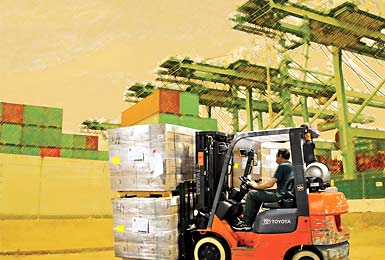Supply Chain Optimization Impacts Site Selection Decision
Getting logistics right isn't just important for business. Booming global population will test infrastructure in unprecedented ways.
September 2010

For most companies, owning or leasing manufacturing, warehousing, transportation, and retail facilities represents the largest fixed-cost element of their businesses. Despite this financial and competitive importance, too few companies have a strategy to continually assess and optimize their supply chain networks to ensure they are meeting their business needs. Companies don't usually design logistics networks; they inherit them as a result of earlier mergers or acquisitions, or simply evolve them piecemeal as operations expand.
Supply Chain and Site Decisions
The forces driving this change are complex. They include typical considerations such as new markets, social and political issues, shifts in investment and trade patterns, changing competitive landscapes, regulatory requirements, infrastructure, consumer demand expectations, labor skills and supplies, and availability and cost of resources. Other forces at work include shortened product lifecycles, demand and availability of product variety, rising energy costs, sustainability issues, increased congestion at ports and on highways, natural disasters, and terrorism. Add to these factors uncertainties about economic recovery and rising debt, and companies find it difficult to even plan for the future, curtailing capital investment.
Take another look at these factors and notice that by adding "location" to each factor, each facet can be either positive or negative to supply chain. Today, industrial and retail site selection must consider the entire supply chain. Missing the dynamic cost and efficiency effects that location plays on their supply chain are crucial mistakes for an expanding company or one reviewing its portfolio. The question is, where are the optimum locations for your supply chain in terms of the four typical influences on competitiveness (cost, time, quality, and risk), and also competition, demand, supply, and service, and by cluster, sector, or industry.
Over the years, location factors have had various degrees of project-specific weighting. However, the top site selection factors have changed. In the past, it was safe to assume that the most important factors regarding cost were labor, real estate, and logistics, in that order. Labor remains a top consideration, especially regarding skill. Real estate, which was typically the second highest cost, is now abundant and affordable. The rising cost of transportation and the growing focus on sustainability has resulted in logistics becoming a top priority. But of all of the location factors to consider, logistics has always been the most complex and difficult to analyze properly. Logistics and supply chain optimization are so important to manufacturers that a logistics analysis is often conducted up front in the manufacturing location decision process to immediately determine the actual search area boundaries.
Most logistics analyses in an industrial site selection project are basic at best. They tend to be high-level analyses where simple transportation costs are compared to various points on a truckload (TL) or container (20-foot or 40-foot) basis, supplemented by an average transportation time frame. This basic information can be easily obtained from shipping companies, but anything more complex is difficult to obtain without an in-depth logistics analysis.
Beware: analyzing the optimal mode, multiple shipping configurations, or conducting network optimization is beyond the capabilities of most site selectors. Brokers and site selection consultants too often claim to be logistics experts, but have only performed basic logistics analyses. Real network optimization requires a professional logistics analysis by trained experts using sophisticated logistics modeling typically requiring GIS capabilities - all of which are major investments. Companies should verify the actual abilities of site selectors and brokers to perform such analyses, including in-depth analysis of the costs of current and planned networks, routing and scheduling, delivery times, mode analysis, and an understanding of points of integration (customs, ports, and regulations).
Project Announcements
Australia-Based Aquatic Leisure Technologies Group Plans Opp, Alabama, Manufacturing Operations
12/11/2025
Teradyne Plans Wixom, Michigan, Robotics Operations
12/11/2025
Robinson Plans Altoona, Iowa, Manufacturing Operations
12/11/2025
BioTouch Expands Columbus, Georgia, Operations
12/11/2025
Natrion Plans Erie County, New York, Battery Components Operations
12/11/2025
Czech-Based GZ PrintPak Expands Mount Pleasant, Wisconsin, Manufacturing Operations
12/11/2025
Most Read
-
The Workforce Bottleneck in America’s Manufacturing Revival
Q4 2025
-
Rethinking Local Governments Through Consolidation and Choice
Q3 2025
-
First Person: Filter King’s Expansion Playbook
Q3 2025
-
Lead with Facts, Land the Deal
Q3 2025
-
How Canada Stays Competitive
Q3 2025
-
Investors Seek Shelter in Food-Focused Real Estate
Q3 2025
-
America’s Aerospace Reboot
Q3 2025



